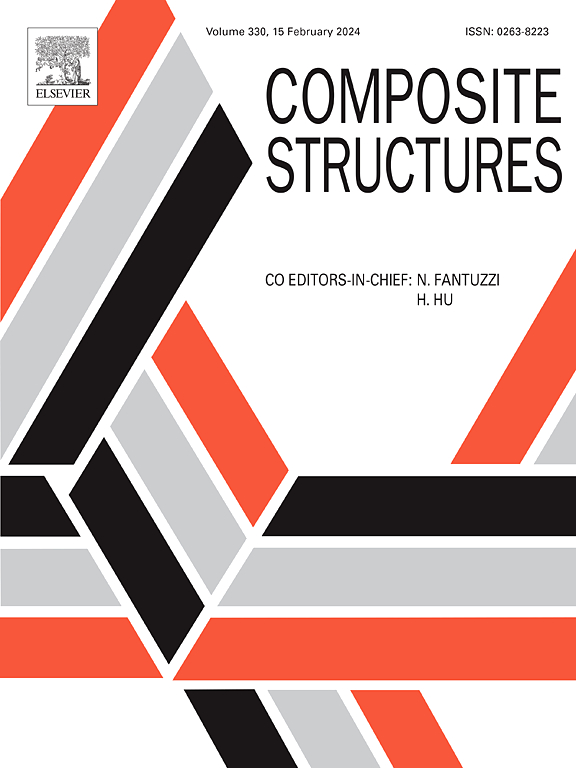On the effect of the load ratio on the bending fatigue of flax-fiber composites
IF 7.1
2区 材料科学
Q1 MATERIALS SCIENCE, COMPOSITES
引用次数: 0
Abstract
Fatigue, a time-dependent degradation process caused by repeated mechanical loading, is one of the most critical factors affecting the durability and reliability of composite materials. While extensive research has been conducted on the fatigue performance of synthetic fiber composites, such as carbon and glass fiber-reinforced composites, studies on the fatigue behavior of natural fiber composites, including flax-reinforced polymers, remain limited. This gap is particularly notable when considering the effects of different load ratios and cyclic loading conditions, which significantly influence the fatigue performance of composites. This paper aims to contribute to the understanding of the fatigue behavior of unidirectional flax fiber-reinforced epoxy composites through systematic experimental investigations. The study focuses on fatigue testing at various stress ratios (R = −1, R = 0.1, and R = −0.1) to explore the effects of different loading conditions on the material’s response. The chosen stress ratios represent full reverse bending, pulsating with no stress reversal, and pulsating with partial stress reversal, respectively, allowing for a detailed comparison of the fatigue mechanisms across diverse loading scenarios. The research presented here evaluates not only the fatigue life but also the evolution of key parameters such as the apparent elastic modulus, energy dissipation, and viscoelastic behavior throughout the fatigue life of the specimens. A notable contribution of this work is the analysis of how the apparent elastic modulus and energy dissipation evolve over the fatigue life, shedding light on the interplay between viscoelastic effects, creep, and fatigue damage under different load ratios. Additionally, the study highlights the relationship between the applied peak load and the material’s nonlinear behavior, offering insights into how fatigue life and mechanical recovery mechanisms influence the long-term performance of flax composites.
载荷比对亚麻纤维复合材料弯曲疲劳的影响
疲劳是影响复合材料耐久性和可靠性的关键因素之一,是由反复机械载荷引起的一种随时间变化的退化过程。虽然对合成纤维复合材料(如碳纤维和玻璃纤维增强复合材料)的疲劳性能进行了广泛的研究,但对天然纤维复合材料(包括亚麻增强聚合物)的疲劳性能的研究仍然有限。当考虑不同载荷比和循环载荷条件对复合材料疲劳性能的影响时,这一差距尤为明显。本文旨在通过系统的试验研究,为了解单向亚麻纤维增强环氧复合材料的疲劳行为做出贡献。研究重点进行了不同应力比(R =−1、R = 0.1、R =−0.1)下的疲劳试验,探讨不同加载条件对材料响应的影响。所选择的应力比分别代表完全反向弯曲、无应力逆转的脉动和部分应力逆转的脉动,从而可以详细比较不同加载场景下的疲劳机制。本文的研究不仅评估了疲劳寿命,而且还评估了关键参数如表观弹性模量、能量耗散和粘弹性行为在整个疲劳寿命中的演变。本工作的一个显著贡献是分析了表观弹性模量和能量耗散随疲劳寿命的变化,揭示了不同载荷比下粘弹性效应、蠕变和疲劳损伤之间的相互作用。此外,该研究强调了应用峰值载荷与材料非线性行为之间的关系,为疲劳寿命和机械恢复机制如何影响亚麻复合材料的长期性能提供了见解。
本文章由计算机程序翻译,如有差异,请以英文原文为准。
求助全文
约1分钟内获得全文
求助全文
来源期刊

Composite Structures
工程技术-材料科学:复合
CiteScore
12.00
自引率
12.70%
发文量
1246
审稿时长
78 days
期刊介绍:
The past few decades have seen outstanding advances in the use of composite materials in structural applications. There can be little doubt that, within engineering circles, composites have revolutionised traditional design concepts and made possible an unparalleled range of new and exciting possibilities as viable materials for construction. Composite Structures, an International Journal, disseminates knowledge between users, manufacturers, designers and researchers involved in structures or structural components manufactured using composite materials.
The journal publishes papers which contribute to knowledge in the use of composite materials in engineering structures. Papers deal with design, research and development studies, experimental investigations, theoretical analysis and fabrication techniques relevant to the application of composites in load-bearing components for assemblies, ranging from individual components such as plates and shells to complete composite structures.
 求助内容:
求助内容: 应助结果提醒方式:
应助结果提醒方式:


